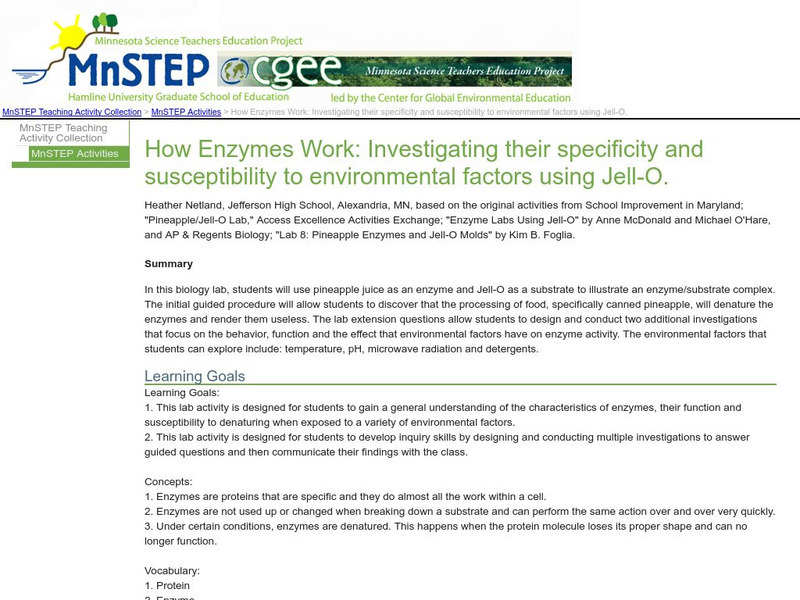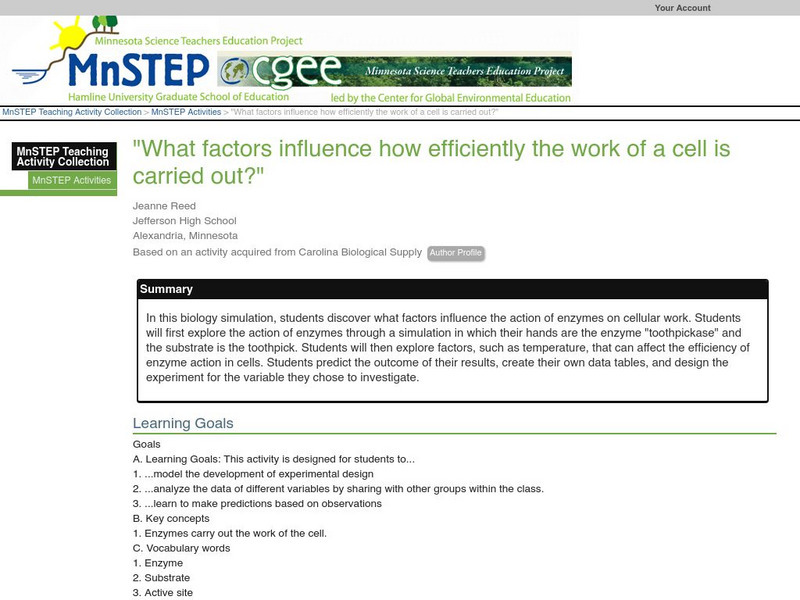Curated OER
Digestive System
In this digestive system instructional activity, students answer a list of true/ false questions. The students answer questions based on their knowledge of each process of the digestive system.
Curated OER
Amphipods
High schoolers identify organisms that live at the bottom of the body of water. In this biology lesson plan, students evaluate the effects of pollution to amphipods population. They examine collected data and create a bar graph comparing...
Curated OER
Water Quality and Temperature
Students are led through three activities to explore the effect of temperature fluctuations on the growth and survival of aquatic plants, clams, and shrimp eggs.
Curated OER
Chesapeake Bay Population Studies
Students determine how to use a quarter meter quadrant to find population density, relative density, frequency and how to calculate a diversity index while participating in a virtual field trip. They study how to establish a Correlation...
Curated OER
Termite Lab
Learners examine insect behavior in a lab activity. Students explore the idea of chemical specificity and the reactions of termites to a chemical found in their trail pheromone. Learners watch a demonstration with termites before...
Curated OER
Macroinvertebrate Simon Says
Students study the four groups of macroinvertebrates. In groups, they explore the characteristics of macroinvertebrates. Through playing a "Macroinvertebrate Simon Says" game, students discover the adaptations of the animals and their...
Curated OER
Kraut Lab
Students explore the process of fermentation through the process of making Sauerkraut. Students use their observational skills and their five senses to create an articulate description of their lab created sauerkraut. They discuss the...
Curated OER
Protein Exploration
Twelfth graders examine protein shapes through a computer program that can be downloaded off the Internet. The program allows students to see how proteins look when viewed with X-ray crystallography.
Curated OER
RP Word Search Puzzle
For this literacy worksheet, students find the words that are related to the concepts that are the theme of the word search. New vocabulary is the focus of the puzzle.
Curated OER
Sound Pictures
Students examine the components of a sonar system. In this physical science lesson students explain how multibeam and sidescan sonar systems are useful to ocean explorers. Students simulate sonar operations in an activity using a...
Curated OER
Molecular Evolution in Plants
Students are using a paper chromatography study that is suitable for introductory biology. The absorption spectra studies and gel electrophoresis studies are appropriate for students who have complete both introductory biology and...
Curated OER
Molecular Evolution in Plants
Students examine chlorophylls. They explore the absorbing pigments in a variety of plants. Through activities, students determine spectrophotometrically. They compare plant proteins from the family Brassicace to assess the level of...
BiologyWise
Biology Wise: Enzyme Substrate Complex
Discusses the properties of enzymes and the concept of enzyme-substrate specificity, and how a substrate molecule binds to an enzyme to form an enzyme-substrate complex. An overview of enzyme-substrate reactions is also presented.
Concord Consortium
Concord Consortium: Molecular Workbench: Enzyme Substrate Docking
View this simulation to observe the docking process for a substrate and an enzyme.
Other
Watercolor painting.com: Watercolor Paper: Your Substrate of Choice
Find out the history behind paper and how it came to be used for painting. Specifications for finding the perfect watercolor paper are revealed.
Science Education Resource Center at Carleton College
Serc: How Enzymes Work
In this biology lab, students use pineapple juice as an enzyme, and jello as a substrate to illustrate an enzyme/substrate complex.
Sophia Learning
Sophia: Active Site: Lesson 4
This lesson shows that an active site is the space on an enzyme where a substrate would attach. It is 4 of 4 in the series titled "Active Site."
BBC
Bbc: Gcse Bitesize: Enxymes
This lesson focuses on enzyme-catalysed reactions and the effect of temperature, substrate concentration, and pH on the reaction rate. It provides a link to an assessment.
Science Education Resource Center at Carleton College
Serc: What Factors Influence How Efficiently the Work of a Cell Is Carried Out?
In this biology simulation, students discover what factors influence the action of enzymes on cellular work. Students will first explore the action of enzymes through a simulation in which their hands are the enzyme "toothpickase" and...
Sophia Learning
Sophia: Enzyme Function: Lesson 4
This lesson will describe how an enzyme is used to turn substrate into product. It is 4 of 5 in the series titled "Enzyme Function."
Sophia Learning
Sophia: Active Site: Lesson 3
This lesson shows that an active site is the space on an enzyme where a substrate would attach. It is 3 of 4 in the series titled "Active Site."
BiologyWise
Biology Wise: Important Factors That Influence Enzyme Activity
Explains what is meant by enzyme activity and the factors that impact on their ability to function. Looks at temperature, pH value, substrate concentration, enzyme concentration, the presence of inhibitors, and allosteric factors that...
CK-12 Foundation
Ck 12: Amino Acids and Proteins
[Free Registration/Login may be required to access all resource tools.] In this module, students investigate amino acids, peptide bonds, and proteins. They also have the opportnity to discover the effect of an enzyme on a biochemical...
Concord Consortium
Concord Consortium: Stem Resources: Molecular Self Assembly
A series of science simulations exploring how molecules assemble themselves and how scientists are learning to engineer their structure. Students will discover what patterns molecules form with interactive lessons. At the end there is a...
Other popular searches
- Enzyme Substrate
- Enzyme Substrate Complex
- Enzyme Substrate Activity
- Enzyme Substrate Complex
- Substrate Model
- Enzymes and Substrates
- Enzyme Substrate Drawing
- Enzymes Substrates
- Enzyme and Substrates





















